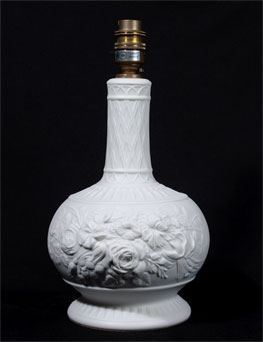
Portmeirion Parian Rose lamp

Portmeirion Parian Rose lamp
See also:
Portmeirion Parian Rose lamp - 9⅝" (244 mm) high.
The height does not include the metal light fitting.Portmeirion
Susan Williams-Ellis bought Gray's Pottery and Kirkham Pottery in 1960. Gray's had been decorating blanks made by Kirkham's for sale in the gift shop at Portmeirion, and later the London showroom owned by Williams-Ellis and Euan Cooper-Willis.
The Gray's factory was later sold, and Portmeirion Pottery, as it was now known, continued from the London Road, Stoke, premises that Kirkhams had occupied since 1946.
A number of cylindrical moulds were left at the Kirkhams plant - they had been used for making medical and laboratory vessels - and Susan put them to use for domestic Portmeirion ranges. The most successful design, Totem, was designed around cylindrical shapes with primitive patterns carved into the moulds. Introduced in 1963, it originally was made in three colours, blue, amber and dark green. The Totem wares had a translucent flow glaze that accentuated the relief pattern. Totem was made in more shapes than any other Portmeirion design and was astoundingly successful all through the sixties and into the seventies. The Totem range was one of the most copied of all designs, and is recognized as typifying the design tastes of the time.
In recent years the transfer printed Botanic Garden range has been very successful. Portmeirion pottery has been produced to the present time, and has found a strong collectors' market.
Further Reading: |
Portmeirion Pottery by Steven Jenkins, Stephen P. McKay, Sue Evans |

